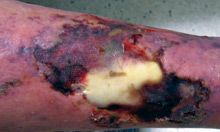Elderly Man With a Non-Healing Leg Ulcer
An 88-year-old man presents with a 2-month history of a non-healing ulcer on his right lower limb.

An 88-year-old man presents with a 2-month history of a non-healing ulcer on his right lower limb. The lesions started insidiously as multiple red nodules that progressively became ulcerated and painful. The patient has hypertension and takes warfarin for atrial fibrillation.
The patient has extensive necrotic ulceration of his shin, covered by black hemorrhagic crust. Laboratory findings demonstrated mildly elevated levels of parathyroid hormone, calcium, alkaline phosphatase, and inflammatory markers. His renal function tests showed moderate impairment. Results of a vasculitic screen were negative.
A subsequent 3-mm punch biopsy of the necrotic lesion demonstrated “benign ulceration,” and an arteriogram of the right lower limb showed calcification of the profunda femoris and superficial femoral arteries.
What is your working diagnosis at this point?
Next page...
CALCIPHYLAXIS
Calciphylaxis is a relatively poorly understood syndrome of vascular calcification and skin necrosis. It is a life-threatening disorder most commonly found in patients with chronic renal disease and secondary hyperparathyroidism who are receiving hemodialysis or who have received a renal transplant.
Calciphylaxis affects between 1% and 4% of patients with end-stage renal disease (ESRD). It is thought to be exceedingly rare in the general population. Mortality rates as high as 60% to 80% have been described; sepsis secondary to infected skin lesions is the leading cause of death.
The pathogenesis of calciphylaxis remains elusive, but is likely the result of the interplay of various comorbid factors or events that lead to vascular calcification, in a setting predisposing to thrombosis.
Many molecular and cytochemical factors have been shown to influence the regulation of calcium mineralization. Recent studies support the idea that the final common end point involves the receptor activator of nuclear factor-kappaB (RANK). The specific factors that induce calciphylaxis in an individual patient, however, are not known.
Although most commonly seen in ESRD, calciphylaxis can also occur in association with obesity and malnutrition, and with other disease entities, such as diabetes mellitus, alcoholic liver disease, primary hyperparathyroidism, malignancy, and connective-tissue disease.
CLINICAL FEATURES
The early lesions of calciphylaxis typically develop suddenly and are intensely painful. They are characterized by nonspecific mottling or livedo reticularis, in addition to violaceous, painful subcutaneous purpuric plaques and nodules. These lesions then rapidly progress to necrotic ulcers with eschars that often become super-infected. Calciphylactic lesions most often manifest on the lower limbs or on areas of adiposity, such as the trunk and buttocks, and may be singular or multiple.
An intact peripheral pulse helps distinguish acral calciphylaxis from peripheral vascular disease.
DIFFERENTIAL DIAGNOSIS
The clinical presentation of calciphylaxis is similar to many other disorders, which can confound the diagnosis. These include atherosclerotic peripheral vascular disease, cholesterol embolization, warfarin necrosis, cellulitis, vasculitis, and cryoglobulinemia.
DIAGNOSIS
Calciphylaxis should be suspected in patients with ESRD and painful, non-ulcerating subcutaneous nodules, non-healing painful ulcers, or areas of skin necrosis. There are no specific laboratory findings. Elevated levels of parathyroid hormone, phosphorus, calcium, and the calcium-phosphorus product may be observed, but are not always present.
Plain x-ray films often demonstrate calcification within the dermis and subcutaneous tissue, although this is a common finding in ESRD and not specific to calciphylaxis. Bone scintigraphy may be used to demonstrate calciphylactic lesions as well as to monitor the progression of disease.
Punch biopsies are usually inadequate, although an incisional biopsy with ample subcutaneous tissue can be diagnostic. Histopathology reveals arterial occlusion and calcification. The most common finding in both early- and late-stage disease is calcifying septal panniculitis.
Calcification within the media of small and medium-sized arterioles with microthrombi and necrosis of subcutaneous fat may be observed.
MANAGEMENT
Treatment should include aggressive wound management, judicious use of antibiotics, and adequate analgesia. Any conditions of hypercoagulability should be sought and addressed. Underlying abnormalities in serum concentration of calcium or phosphorus need to be corrected. This can be achieved with non–calcium-containing phosphate binders, such as sevelamer.
Calcimimetics, such as cinacalcet, may be beneficial in cases with hyperparathyroidism. Some benefit may be attained by increasing the frequency or duration of dialysis sessions.
Recent reports have demonstrated marked improvement in calciphylaxis with intravenous sodium thiosulfate. This potent antioxidant also increases the solubility of calcium deposits.
For patients with refractory hyperparathyroidism in whom conservative management has failed, parathyroidectomy should also be considered.
PROGNOSIS
Calciphylaxis is a lethal disease that is associated with high morbidity and mortality. The response to any therapeutic regimen is poor. Sepsis and organ failure are common complications. Currently, the optimal management includes maintaining a high index of suspicion for those patients who are at risk.
References:
References:
1. Arseculeratne G, Evans AT, Morley SM. Calciphylaxis-a topical overview. J Eur Acad Dermatol Venereol. 2006;20:493-502.
2. Kalajian AH. Calciphylaxis with normal renal and parathyroid function. Arch Dermatol. 2009;145:451-458.
3. Weenig RH. Pathogenesis of calciphylaxis: Hans Selye to nuclear factor kappa-B. J Am Acad Dermatol. 2008;58:458-471.